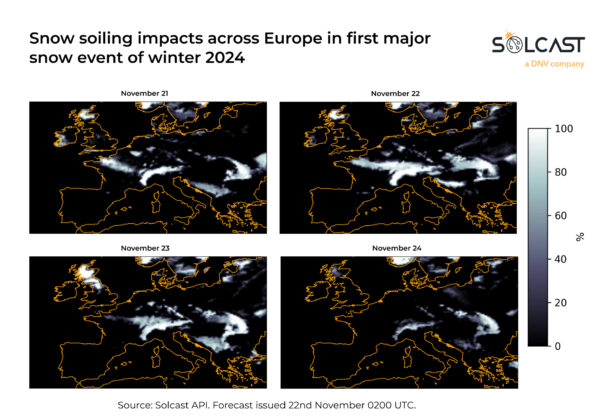
Solar production across much of Europe is expected to dip over the weekend as a significant low-pressure system draws polar air across the continent, bringing the first large widespread snowfall of the season, according to analysis using the Solcast API. France, Germany, Scotland, and parts of Eastern Europe are expected to see the greatest reductions in solar generation. The snow event, which began Thursday, will progress eastward over the weekend, with the most significant impacts occurring on Saturday before conditions improve by Sunday afternoon.
In Germany, snow settling on panels is forecast to reduce behind-the-meter (BTM) generation by up to 30% over the weekend. The impacts are expected to be most pronounced in southern and western regions served by the Transnet-BW TSO, while the 50Hertz area in the northeast will remain largely unaffected. Meanwhile, without large-scale snowfall, France is anticipated to see a more modest reduction of up to 10%. These impacts should be largely resolved by Sunday, as rising temperatures and sunshine are forecast to clear snow from panels. In the UK, significant soiling effects will be seen in Scotland where large snowfalls are expected, however as UK generation capacity is concentrated in the south, this will only result in a reduction of around 5% in national solar output.
The primary period of disruption to solar generation is expected to occur on Saturday after a major snow dump. As temperatures climb during the day, a combination of sunlight and warming will initiate the sliding of snow off panels. Whilst it can take a few days for snow soiling impacts to build up, they often clear quickly. As snow starts to melt, a thin layer of meltwater forms between the snow and the panels, allowing for the snow to slip off in large sheets. This mechanism ensures that solar panels often clear of snow well before the surrounding ground does, so snow soiling impacts will mostly be clear by Sunday afternoon, and grids are likely to see solar capacity coming back online.
Snow deposition and clearing events like this are rare and challenging to predict. Solcast directly models these phenomena using satellite and weather data to estimate the accumulation and sliding of snow on solar panels. While machine learning tools can struggle with the discontinuous and localized nature of such events, Solcast’s proprietary methods enable high-resolution forecasting of production impacts. Explicitly treating snow soiling losses in your power modeling, helps quantify the duration and extent of such disruptions, and allows for more accurate forecasting whether for individual assets or grids.